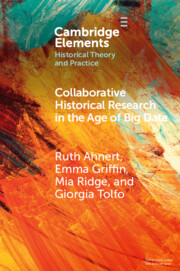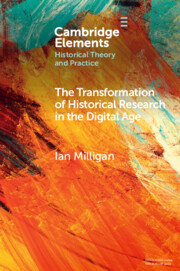Refine search
Actions for selected content:
10 results
What is Digital Global History Now?
- Part of
-
- Journal:
- Transactions of the Royal Historical Society , First View
- Published online by Cambridge University Press:
- 24 March 2025, pp. 1-19
-
- Article
-
- You have access
- Open access
- HTML
- Export citation
13 - Digital History, GIS, and Spatial Humanities
- from Part II - Perspectives and Methods
-
-
- Book:
- The Cambridge Companion to Ottoman History
- Published online:
- 31 May 2025
- Print publication:
- 20 March 2025, pp 181-201
-
- Chapter
- Export citation
AI as a Historical Lens: An Experiment in Periodization of Russia’s State Photography Archive with Neural Networks
-
- Journal:
- Slavic Review / Volume 84 / Issue 1 / Spring 2025
- Published online by Cambridge University Press:
- 21 July 2025, pp. 1-22
- Print publication:
- Spring 2025
-
- Article
- Export citation
Introducing The View from the Sea. The Practice of Early Modern Transoceanic Commercial Navigation
-
- Journal:
- Itinerario / Volume 48 / Issue 1 / April 2024
- Published online by Cambridge University Press:
- 28 May 2024, pp. 14-24
-
- Article
-
- You have access
- Open access
- HTML
- Export citation
Foreword
-
- Journal:
- Itinerario / Volume 48 / Issue 1 / April 2024
- Published online by Cambridge University Press:
- 07 May 2024, pp. 10-13
-
- Article
-
- You have access
- Open access
- HTML
- Export citation
Hearing the Americas: Understanding the Early Recording Industry with Digital Tools
-
- Journal:
- The Journal of the Gilded Age and Progressive Era / Volume 22 / Issue 4 / October 2023
- Published online by Cambridge University Press:
- 15 December 2023, pp. 427-451
- Print publication:
- October 2023
-
- Article
-
- You have access
- Open access
- HTML
- Export citation

Collaborative Historical Research in the Age of Big Data
- Lessons from an Interdisciplinary Project
-
- Published online:
- 26 January 2023
- Print publication:
- 09 February 2023
-
- Element
-
- You have access
- Open access
- HTML
- Export citation

The Transformation of Historical Research in the Digital Age
-
- Published online:
- 05 August 2022
- Print publication:
- 18 August 2022
-
- Element
-
- You have access
- Open access
- HTML
- Export citation
1970s Drought, State Crisis, and Opportunities for Transnational River Development in the Senegal Basin
-
- Journal:
- African Studies Review / Volume 64 / Issue 4 / December 2021
- Published online by Cambridge University Press:
- 01 December 2021, pp. 776-802
-
- Article
- Export citation
Harvesting Big Biographical Data for Chinese History: The China Biographical Database (CBDB)
-
- Journal:
- Journal of Chinese History / Volume 4 / Issue 2 / July 2020
- Published online by Cambridge University Press:
- 12 August 2020, pp. 505-511
-
- Article
- Export citation
